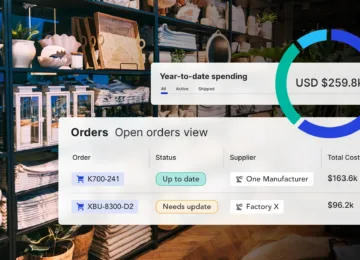In order to be successful, there are many best practices that production facilities need to consider when putting their schedules and plans together. Perhaps most significantly, everyone involved needs to clearly understand every part of the production process, from the small details to the big picture — otherwise, you risk missing key items that could slow down or even halt production.
Having a production plan is a great way to put your production and manufacturing processes on track right from the start, as it helps you prepare for what needs to be done. A production planning template even takes you one step further by providing an outline for your planning process, making it easier to form a cohesive and successful production plan.
What Is Production Planning?
A production plan is a guide that outlines every step involved in the production of a good. With production planning, the production process is more organized and efficient, and there is less of a risk of missing an important step that stops or slows down production. These plans help optimize the manufacturing process, which makes the design, production, and delivery of goods much easier to plan out.
A production plan includes steps for each part of your manufacturing process. This might include what the products are, the type and quantity of materials needed to produce them, the production schedule, and the delivery schedule. It could also include a schedule that shows who is responsible for each part of the process.
Most production plans include details about which machines are needed during the process, how many pieces of equipment are involved, and what quality assurance steps need to be taken before the product is ready for final delivery.
Why Is Production Planning Important?
Like most processes, planning plays an integral part of the production process. When you have a solid plan in place from the beginning, you have clear targets and a firm idea of what needs to happen in order to meet your goals. This reduces the chances of bottlenecks, which can lead to slowdowns that impede your productivity.
The ultimate goal of production planning is to create a more streamlined production process that lends itself to greater efficiency. More efficient processes lead to overall improvement in metrics and key performance indicators (KPIs). Tracking metrics and KPIs via digital tools and dashboards gives you at-a-glance insights into whether or not you are meeting production goals — which can let you know if your production plan needs to be tweaked.
Production planning also helps manufacturing businesses be better at resource management and capacity planning. Rather than having an overabundance of raw materials (or not enough) for production, you can plan out exactly what you need and avoid supply chain hold ups or unnecessary expenses. This gives you greater control over your inventory management and improves your lead times as well.
Another benefit of production planning is the internal alignment it creates. A clear production plan can be shared across your organization, from machine operators to upper management, which keeps everyone on the same page regarding production. When everyone is working from the same plan, you can more easily avoid internal conflict and confusion surrounding production, while also creating a more streamlined workflow across teams with fewer bottlenecks.
Breakout: What Is the Difference Between a Production Schedule and a Production Plan?
Often, there is confusion around the terms “production schedule” and “production plan.” Both deal with the organization and high-level strategies around production, and while there are similarities, the two terms mean different things. A production schedule has clearly defined and assigned roles for each step of the manufacturing process, along with the timeline for when those tasks need to be accomplished.
The production plan, on the other hand, determines what needs to be produced and how much of it needs to be completed in each run. Another way to think about the two is that the production plan outlines the “what” — the steps and materials needed to produce a good — while the production schedule outlines the “who” and “when” — who is responsible for each step of the process and when they need to have them done.
What Are the 3 Stages of Production Planning?
There are three major stages of production planning that an organization needs to follow. If you complete the stages out of order or leave one out entirely, your production plan could end up being incomplete. This can lead to missed steps and bottlenecks that cause issues throughout the entire production process. Next, we’ll take a look at each phase in greater detail.
Planning Phase
The planning phase addresses the end goals of your production process and helps you determine what type of schedule and plan is best suited to help you achieve your goals. This could include steps like:
- Product development
- Design
- Sales forecasting
- Aggregate planning
- Raw material planning
Action Phase
The action phase of the production plan outlines the different steps that need to be taken in order to create the product that your plan is for. This phase addresses all of the steps of production, from the initial job order to the final delivery and everything in between. Those specific steps might include:
- Process routing
- Material planning
- Tool planning
- Machine loading
- Scheduling
Control Phase
The final stage of the production planning process is the control phase. This phase helps ensure that all the other steps in the planning and action phases are measured and reported correctly, which ensures that end goals are being met. This also includes any measures needed to fix errors in the plan and addresses any mistakes that might come up during the production process. The main steps in this phase are:
- Progress reporting
- Metric tracking
- Corrective action planning
What Are the Benefits of a Production Plan?
A production plan provides many different benefits that organizations across the globe can benefit from. It provides clear benchmarks for measuring key elements of the production process and ensures that the entire organization is clear about what the production process is. When manufacturers utilize a production plan, they can avoid confusion, waste, and delays. This helps provide a better customer experience and makes sure that manufacturers deliver on the promises they make to suppliers and purchasers. Other benefits include:
- Resource management
- Supply chain planning
- Internal project alignment
- Goal and milestone tracking
- Increased clarity
- Singular database for tracking and minimizing backlogs
- Team-wide visibility into production
- Streamlined workflows
While production planning offers many different benefits, many manufacturers may still shy away from the idea because the process of creating the plan is too overwhelming to think about. Luckily, Anvyl’s production planning template alleviates the pressure of building a plan from scratch, which can get your organization on the right track much sooner.
Download Anvyl’s Production Planning Template
How Do You Create a Production Plan in Excel?
Many production plans are built using spreadsheet software like Microsoft Excel or Google Sheets. You can use these programs to create Gantt charts, which clearly lay out the different elements of the production process in a visual format. This helps with project management and tracking everything from customer orders to the bill of material that is required for each product. These are simplistic charts that any member of your team can follow.
A production plan includes details like:
- Company information
- Customer information
- Current order status
- Production or product numbers
- Product variations
- Starting inventory
- Current inventory
- Manufacturing dates
- Operator or management notes
Each organization functions differently, so no two production plans will be the same. There will be some level of customization required, even if the plan comes from a standardized template.
An Excel template can work as a jumping-off point, allowing your business to build around your own goals and needs without starting from scratch. Keep in mind that a template should be flexible enough to allow for personalization while also being rigid enough that you don’t miss vital steps. The Anvyl production planning template was built with this mentality: to help manufacturers improve their processes and create a better production planning experience with a unique, customizable approach.
Try Anvyl’s Free Production Planning Template
At Anvyl, we understand that there are a lot of considerations to keep in mind as you work on creating your production plan. This is why we provide a planning template that you can use to optimize your production planning, project management, and capacity planning — all while reducing bottlenecks and avoiding production shutdowns.
The Anvyl production planning template was created to make the entire process of production planning easier for you and your team. Rather than creating a production plan from scratch, you can get started faster by using our template. The legwork is already done for you — all you need to do is customize the Excel spreadsheet to fit your business.
Get your free download of our production planning template and get started today.
Take Control of Your Production Process With Anvyl
Having control over your production process ensures that you are optimized for success and efficiency. When you don’t have a production plan, it’s hard to see whether or not you’re hitting your benchmarks — which makes it even harder to hit your goals.
When you have a well-constructed production plan organized in a versatile Excel template, you can build a strong production process that can withstand challenges and produce the results that your organization desires.
Investing in a platform that helps you streamline your processes is a great way to benefit your business. With resources like Anvyl, you can create a centralized database and manage your supplier relations with ease. Our team has been helping manufacturers manage their production planning for many years — try a product demo to learn more about what Anvyl can do for your organization.



